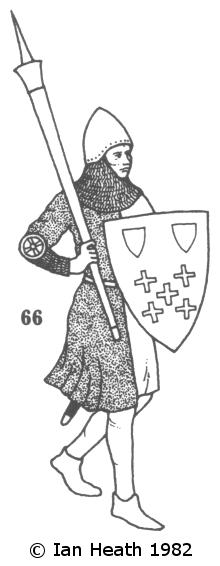|
|
LOW COUNTRIES FOOT-SOLDIER, 14th CENTURY
An extract from Armies of the Middle Ages, volume 1
by Ian Heath

66. LOW COUNTRIES FOOT-SOLDIER, 14th CENTURY
This figure is taken from a surviving engraving of the Leugemeete, a lost 14th century fresco depicting unformed soldiers of the Weavers Guild of Ghent,
the escutcheons on his shield probably bearing the arms of his guild.
The fresco showed three bodies of men, the first of archers and pikemen, the second of crossbowmen, and the third of pikemen and men armed with plançon à picots as here
(see below). The first 2 units also wear uniforms, but of a single colour rather than mi-parti.
Uniforms were apparently in use among Low Countries towns and guilds from the very beginning of the 14th century and possibly earlier,
guild members wearing the livery or badge of their professional association.
Froissart actually gives us a list of uniforms worn in Philip van Artevelde's army at Roosebeke in 1382 which,
if he has given them all the same sequence as the various contingents he lists as being present, would give us the following town liveries:
| Ghent: | Blue and yellow (which seems to tally with the Leugemeete, the actual colours of which are unknown). |
| Alost: | Black bend on red. |
| Grammont: | White chevron on a blue jacket. |
| Courtrai: | Paly of green and blue. |
| Bruges: | A fess chequy of black and white (given as the fifth uniform in most versions, but al least one precedes it with blue and red lozengy). |
| Damme: | Red and white quarterly. |
| Sluys: | Blue with a red quarter (some versions say all blue'). |
| Le Franc: | (Presumably the Franc of Bruges, an area of Western Flanders dependent on Bruges) 'Cut with red above and white below'. |
In addition we know that the Liègeois wore red uniforms in 1467.
As already mentioned, the weapon carried here is a plançon à picot, often erroneously identified as a goedendag by modern authorities.
It had a shaft of about 5½ feet, broadening at the top where a socket and iron spike were fitted.
The plançon a broche was the same but with a longer, more slender spike, and the chandelier was also similar but with more of a club-like socket.
Froissart refers to these weapons simply as 'spiked staves'; he refers to Artevelde's men as each carrying a staff with an iron spike and ferrule'.
The plançon was banned by some late-14th and early-15th century statutes and fell out of favour after the 14th century.
In closing on the subject it should just be noted that the plançon was possibly also in use elsewhere,
having been borne by 2 figures on the Hastings brass of 1347 (where the account of 1408 describes it as 'grande baston'),
though this particular brass may in fact be the work of Flemish (more probably French) craftsmen.
Lowland troops on the Courtrai Chest,
where the plançon is also prominent, are basically identical to this figure;
those representing the Ypres contingent
have a Lorraine cross on their breasts.
[Based on the Leugemeete fresco]
67. LOW COUNTRIES PIKEMAN c.1398 in Armies of the Middle Ages, Volume 1 by Ian Heath
|

